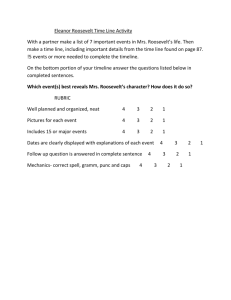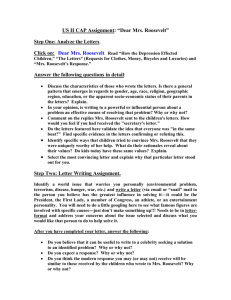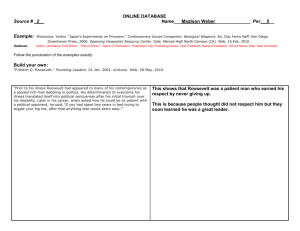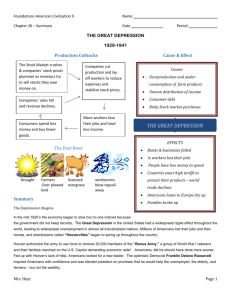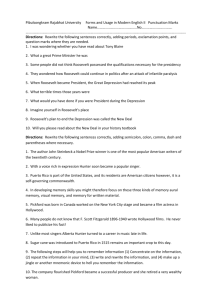Language Arts Lesson 1 - The University of West Georgia
advertisement
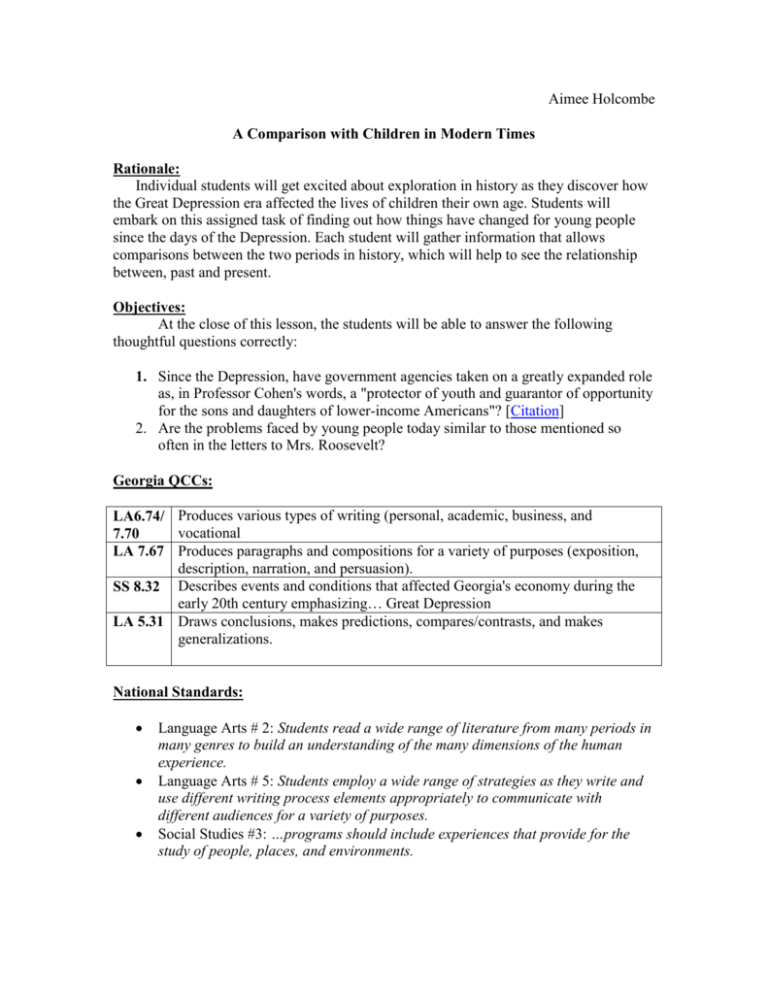
Aimee Holcombe A Comparison with Children in Modern Times Rationale: Individual students will get excited about exploration in history as they discover how the Great Depression era affected the lives of children their own age. Students will embark on this assigned task of finding out how things have changed for young people since the days of the Depression. Each student will gather information that allows comparisons between the two periods in history, which will help to see the relationship between, past and present. Objectives: At the close of this lesson, the students will be able to answer the following thoughtful questions correctly: 1. Since the Depression, have government agencies taken on a greatly expanded role as, in Professor Cohen's words, a "protector of youth and guarantor of opportunity for the sons and daughters of lower-income Americans"? [Citation] 2. Are the problems faced by young people today similar to those mentioned so often in the letters to Mrs. Roosevelt? Georgia QCCs: LA6.74/ Produces various types of writing (personal, academic, business, and vocational 7.70 LA 7.67 Produces paragraphs and compositions for a variety of purposes (exposition, description, narration, and persuasion). SS 8.32 Describes events and conditions that affected Georgia's economy during the early 20th century emphasizing… Great Depression LA 5.31 Draws conclusions, makes predictions, compares/contrasts, and makes generalizations. National Standards: Language Arts # 2: Students read a wide range of literature from many periods in many genres to build an understanding of the many dimensions of the human experience. Language Arts # 5: Students employ a wide range of strategies as they write and use different writing process elements appropriately to communicate with different audiences for a variety of purposes. Social Studies #3: …programs should include experiences that provide for the study of people, places, and environments. Social Studies # 10: …programs should include experiences that provide for the study of the ideals, principals, and practices of citizenship in a democratic republic. Estimated time: Two 50-minute class periods Procedures: *This lesson serves as a follow-up to a discussion of the letters to Mrs. Roosevelt, and a study of the New Deal agencies that brought aid to young people during the Depression. It focuses on two questions posed by the Dear Mrs. Roosevelt feature material: Since the Depression, have government agencies taken on a greatly expanded role as, in Professor Cohen's words, a "protector of youth and guarantor of opportunity for the sons and daughters of lower-income Americans"? [Citation] Are the problems faced by young people today similar to those mentioned so often in the letters to Mrs. Roosevelt? Therefore, it will be important to begin the lesson by reading some of Mrs. Roosevelt’s letters and discussing who she is and why she would have received such letters as an anticipatory set. 1. Have each student read a letter to Mrs. Roosevelt and list the problems the young writer mentioned in the letter on a piece of notebook paper. (Brainstorming) 2. Put the students into small cooperative learning groups. 3. Each student briefly tells of the focus of his/ her letter to the other students in the group (reciprocal teaching). The groups combine their individual lists from reading the letters into one group-brainstorming list. Label this column “1930s.” (This list should go down the left side of the paper in a column. Have students fold the paper in ½ first.) 4. In the groups, create a brainstorming list of problems that young people face today on the right side of the paper. Label this column “2000s.” 5. As a group, look at both of the lists of problems them and now, and have students draw lines from left to right where items correspond. 6. Class discussion and share time of brainstorming lists. Ask students to compare the lists and note the similarities and differences between the problems faced by 1930s and 2000s youth. Teacher should be sure to bring out the key elements of both decades during this time, such as nutrition, supply, economy…etc. 7. Each student in the group then uses their own artistic abilities to create a Vinn Diagram poster that organizes the group’s lists, making sure to clearly represent the likes and differences between life for young people in the two eras. 8. Ask students Questions: Which side is longer? Do students think that young people of the 2000s face greater challenges than young people of the 1930s? Based on their research, do students think today's young people have a better chance of receiving help for their problems that their 30s counterparts? Does it seem likely that the government's expanded role in our lives today is a legacy of President Roosevelt's New Deal Programs? What modern services do you know of are available to the poor and disadvantaged in today’s society? 9. Ask students to choose one of the letters written to Mrs. Roosevelt, perhaps one that seemed particularly convincing to them. Invite them to write a response letter from a modern point of view, making suggestions on how they might get assistance from today's social programs. The letter should be at least one full page in length. (The letter needs to follow the formal guidelines for composing a business letter.) Evaluation: Students should turn in assignments from the lesson and be graded as follows: Product Brainstorming lists Vinn Diagram Poster Point Value (Out of 100 Total) 15 25 Response to Questions Letter 25 35 Breakdown 7.5 pts. for each decade 5= colorful; 5= neat and organized; IF there are at least 5 items in each of the following sections, then 5= for 1930s, 5= 2000s; 5= “same” section in middle 5 pts. for each question (5 questions) 5= rough draft; 5= final copy; 10= correct letter format; 10= grammar and spelling; 5= length and content Lesson Idea and some content courtesy of: http://newdeal.feri.org/classrm/clasdmr3.htm
